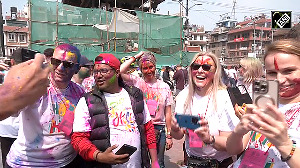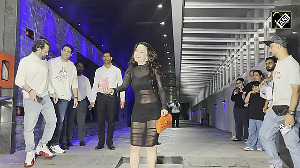This is a very unusual case. Here I have the custody of an accused who is giving me evidence after evidence, but I can't do anything about collecting it because they are lying across the border in another country," says Rakesh Maria, Joint Commissioner of Police, Crime, Mumbai.
That other country is Pakistan and the accused is Ajmal Amir Kasab, the only terrorist captured alive in the Mumbai attacks of November 26.
Maria and Kasab, investigator and accused, both share the same mother tongue: Punjabi. Kasab's Punjabi-Urdu is not difficult for Maria to understand and decipher.
Being in a profession that deals with human complexities at every step, Maria -- who monitored the situation from the police control room throughout the 60 hour siege of Mumbai, November 26 to 29 -- has played the tricks of his trade and applied the magic of human psychology on Kasab.
The way the Mumbai police has been able to reconstruct the entire case shows that Kasab seems to be cooperating with the Mumbai police.

Maria is all set to prepare and ink the chargesheet within 90 days as stipulated by Indian law.
He belongs to the 1981 batch of the Indian Police Service. His first posting was as assistant superintendent of police in Akola, and then Buldhana, in the interiors of Maharashtra. He came to Mumbai in 1986, where he became famous and influential in no time.
The police officer leads two fascinating lives without either of them intersecting. He has some good friends in Mumbai's film industry, sports and business. An avid player of basketball and practitioner of tae-kwon-do, he also boasts an enviable circle of faceless informants in the Mumbai underworld. The tall and good-looking Maria is a smart mix of ambition and professionalism, of soft manners and a dreaded ruthless approach in dealing with the dark and brittle underbelly of Mumbai.
The biggest challenge in his career was the task of investigating the Mumbai serial bomb blasts of March 12, 1993, which killed 257 people. At the end of the investigations the police had a 10,000-page chargesheet, 123 accused and more than 600 witnesses. Time has proved that Maria's pursuit of Dawood Ibrahim and Tiger Memon was correct. After the 1993 blasts investigations Ibrahim could never regain his grip over the city.
All the hard work done by Maria's team was vindicated when most of the arrested accused in the 1993 blasts were proved guilty and many of them got the death sentence in 2007. After that celebrated case his career was mired by controversies and office politics till he was assigned to investigate the blasts at the Gateway of India and on a Mumbai bus in 2003.
Many people forget that, again, in the entire country this was a rare terrorism case that got solved convincingly. The same way, recently Maria was able to solve the mystery of the e-mail writers of the Indian Mujahideen.
Maria's knowledge of Mumbai's underworld, operators of the drugs trade and other illicit activities, and his ability to understand serious issues like communal sensitivity, are all so vast that one can't do without meeting him to know the real face of the city.
The man can eloquently debate America's 9/11 investigations as well as the social profile of the fatichar (paupers) in his custody. At least one chapter in writer Suketu Mehta's celebrated book Maximum City banks on Maria's exclusive experiences. Still, Maria has an infinite number of critics who think his skills are over-hyped as is the man himself, but in a city of more than 10 million such nuances hardly matter to the common people who desperately seek security.
Over-hyped Maria or underplayed Maria, all are welcome if he is fixing the criminals, the mafia and, now, terrorists.
Once again, Maria's 27 years of policing experience came in handy when he met Kasab for the first time on the morning of November 27. Maria, who is in charge of the entire Mumbai terrorist attacks case, says modestly, "If you (the media) get impressed by the indoctrination of these youth that turned them to terrorism and brought them to Mumbai from Karachi, then you very well trust us too. We underwent three years of the Indian police's rigorous training and 27 years of experience in dealing with criminal brains. Don't underestimate our investigative skills."
In his first exclusive one-on-one interview since taking over the critical case, Maria, one of the busiest men in a city teeming with busybodies, shares his views on the Mumbai terror attacks with rediff.com's Sheela Bhatt, and clears many doubts too.
How different is the Mumbai terror attacks of November 26, 2008?
You cannot draw parallels.
In 1993, they brought in the explosives by sea. This time both the explosives and foot soldiers, the executors, have come by the sea route.
In 1993 there was not so much use of sophisticated communication equipment. Here, there is a lot of use of sophisticated communication.
In 1993, the blasts took place at 13 locations. This time they planned blasts at seven locations, but at three places the bombs were defused.
But, at the Hotel Oberoi, Taj Mahal hotel, Nariman House, Cafe Leopold and at the Chhattrapati Shivaji Terminus, there was random firing.
Fifty-eight people were killed at CST; 33 people were killed at the Oberoi; 32 killed at the Taj Mahal hotel; 10 at Leopold; and eight people were killed at Nariman House.
In addition, these attacks had a distinct hostage situation. They took hostages and laid siege to the locations. All the doubts are created unnecessarily because people don't know that in all places the terrorists occupied the higher levels and prevented the security forces from getting close. They were using assault rifles like AK-56 and AK-47, 9mm pistols, hand grenades, explosives. Each terrorist was carrying eight kg of explosives.
The fact is they came by the sea route, the fact is they used Al Husseini, the Lashkar-e-Tayiba's boat up to the international waters. Then, they hijacked the Indian fishing trawler Kuber to sail through Indian waters. Then they came all the way, crossing 592 km, to reach Mumbai. Only then they killed the tandel Amarsinh Solanki who was driving the Kuber.
Then, in an inflatable dinghy with out-boat-engines they came up to some four nautical miles from the Badhwar Park fishermen's colony (in Cuffe Parade, south Mumbai) and then headed for the shoot-out.
March 12, 1993, and November 26, 2008, are going to be marked as watershed dates in the history of terrorism not only in India, but in the world.
Never in the world, at any place, was a hostage situation simultaneously going on at four locations in a congested city. On that night from 9.30 onwards bomb blasts were going on, terrorists were moving about in vehicles on the roads of Mumbai, opening fire and killing people.
Eighteen police officers were killed and 36 officers injured while encountering these terrorists. 163 people have died, 315 have been injured. Twenty-six foreigners have died while 22 foreigners were injured. All these things, you know, are unprecedented.
This event has attracted international attention, opinions and critical commentary. The most common critique is, how come 1,600 security forces consisting of policemen, the National Security Guard and the Indian Army and Navy took 60 long hours to nab only 10 terrorists?
The reason behind the long hours of operation is that the terrorist had gone to the higher levels.
Two, the security agencies were not sure of the number of hostages being held behind the terrorists' positions inside the rooms. We didn't know if there were hostages or not.
If you just enter their area and kill them the entire event would have taken just an hour. But we were not sure if there were hostages or not, how many of them were there if any. We were not aware if children, women and aged people were held as hostages or not. That prevented us from killing them quickly.
Three, if you know the architecture of the Taj Mahal and Oberoi hotels, both have atriums. Terrorists had gone to the higher locations and were controlling the assault from above. Whenever anybody tried to climb up, they were hurling hand grenades and firing from AK series rifles, so it took time. Those who criticise our response should study the event in its entirety.
The situation at VT station (CST, as it is known today) didn't last for more than 10 minutes. Our police, with whatever weapons they had, even with lathis, pushed them out of the station premises. They came out to The Time of India building, they came to the special branch (of the Mumbai police), they rushed to Cama hospital. They went to Rang Bhavan, they went to Vidhan Bhavan (the Maharashtra assembly). Ultimately, they faced an encounter at Girgaum Chowpatty. They were chased all the way there. They didn't get even a single moment.
At CST they could not hide at a higher location so our security men finished the job in 10 minutes. But, at the Taj Mahal and Oberoi hotels and at Nariman House, because they took advantage of the location and because, I repeat, one was not too sure if terrorists were with how many hostages in the rooms, one took precautions.
Look at the other fact. There were more than 500, 600 people at the Taj Mahal hotel when it was attacked, but the casualty was restricted to 32. At the Oberoi there were more than 400 people present, but the casualty is 33. We had to take care and precautions to save innocent lives. That was the only reason to take time in this operation. Our operation was not about 10 terrorists, it was all about saving lives.
Who were these ten people? Each of them was carrying AK-47 rifles. Each of them had 10 to 12 magazines of 30 rounds each. Plus, some 100 to 150 spare rounds of bullets. All of them also had one 9mm pistol with two magazines, plus they had hand grenades. We had to take care of our citizens against such explosive power.
Part II: 'Where was the question of negotiations?'
Part III: 'The Pakistan connection is beyond doubt'
Image: Mumbai's Joint Commissioner of Police (Crime) Rakesh Maria (in a blue shirt) with Police Commissioner Hassan Gafoor, right. Photograph: Arun Patil






 © 2025
© 2025